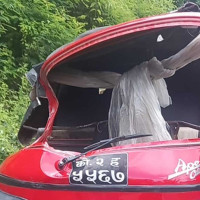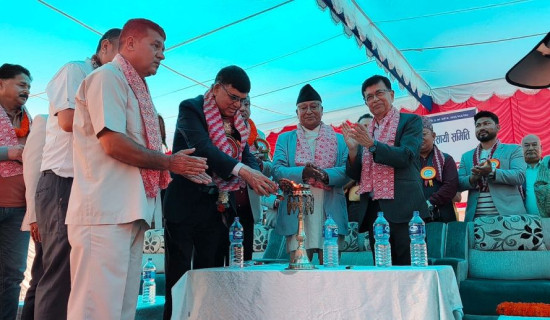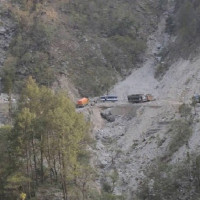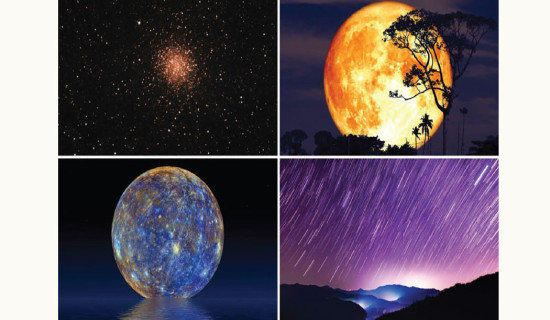- Friday, 4 July 2025
Ama Yangri Journey
At 3:00 am, a cellular alarm occurred at 3,200 metres above sea level, 90 kilometres north-northeast of Kathmandu Valley, at Ama Yangri Basecamp. My friends and I were sleeping in tents upon the high mountain, exhausted from yesterday's journey. I did not want to wake up but remembered my determination and enthusiasm, stepping out of the tent and waking up my friends. A waxing gibbous moon was hanging in the sky, illuminating the frozen, cold air. The silver mountains stretched majestically before me, with Ama Yangri Peak towering on my right side.
All my drowsiness, tiredness, and biting cold that had overcome me earlier melted away at that moment. The spectacular view during the early dawn took me into a state of wonder. My thoughts wandered to the vastness of the universe and my infinitesimality—a small ant trodding on these vast expanses. I was utterly overwhelmed, humbled, and inspired by the sheer brilliance that stood before me.
Helambu mythology mentions Ama Yangri, the Mother Goddess, a golden-winged hawk who defeated the demon Yama at the expense of her life to rescue the nation. Her rock incarnation is now worshipped at the top of a hill. It was 3:30 am, and we searched for a water bottle locked inside our jeep. The wind was chilled, but we knew we would need water to wet our dry mouths after the steep climb.
Amidst the chaos, Bishnu Dai misplaced the jeep key, likely because he was exhausted. He could not remember where he had stored it, and we all started searching desperately. Time was short, and we were pressured to be on top by 6:30 am at any price. Then Dipesh Sir spotted the key, enabling us to return the water bottle and continue.
Unfortunately, Dipesh Sir could not continue with the ascent due to severe leg cramps. Reluctantly, we left him to recover in the tent as we continued climbing. The trip continued without him.
This was not my first high-altitude mountain hike. I had previously hiked up to Poon Hill with my university friends, but now I was hiking with colleagues from the office. As we began hiking up Ama Yangri Peak, Pratikshya was sure, citing how she had done a seven-hour hike before, so this three-hour hike was a cakewalk. But as the trail continued to rise and the height increased, Pratikshya started losing confidence and stamina.
While the rest of the team were on their way, Shivaji and I stayed behind to encourage and reassure her. Despite our issues, we stood with Pratikshya hand in hand. We finally reached the summit with teamwork, dedication, and persistence. As we ascended, the breathtaking view of white-clad peaks appeared before us. Ama Yangri Peak offered stunning views of the Langtang Lirung, Ganesh Himal, and Dorje Lakpa ranges and a broad sweep of the Himalayan range and the valleys below.
The landscape was a photographer's paradise and spiritual haven. For those in search of the most thrilling Himalayan landscape, the Ama Yangri trek holds a top place over customary vistas of Poon Hill and Mohare Danda. Bishnu Dai, who has both experienced it, tends to agree that Ama Yangri outweighs him in scale and grandeur.
"I've ascended Poon Hill, enjoying its well-landscaped sunrise vistas of Dhaulagiri and Annapurna. But as I stood at the top of Ama Yangri's peak at sunrise, I was utterly stunned. The 360° panorama of Himalayan giants like Makalu, Dorje Lakpa, and Manaslu wrapping around the Langtang ranges and Ganesh Himal was indescribable. Seeing the sun rise, I was speechless, dumbfounded by the majesty of these white, glinting giants. I sat there for hours, speechless, as the golden radiance of dawn illuminated the expansive landscape." If you're looking for a Himalayan landscape that touches your soul like nothing else, the Ama Yangri trek provides an unequalled visual feast. As individual accounts attest, no amount of Poon Hills or Mohare Dandas can compete with this out-of-the-world experience. Ama Yangri is not just a trek; it's a trip to the heart of the Hyolmo culture. The locals' generosity, culturally rich traditions, and pure natural surroundings make an experience that stays in your heart.
Despite the bumpy ride to the base camp, the destination is well worth the journey. The trek is the ideal mix of natural splendour and cultural diversity, making it one of the most accessible and satisfying Himalayan treks. It teaches us that travel is as much about getting there as it is about appreciating the little, unobserved things in between, transposing them into a lifetime of memories.
BIT, Patan Multiple College









-original-thumb.jpg)







